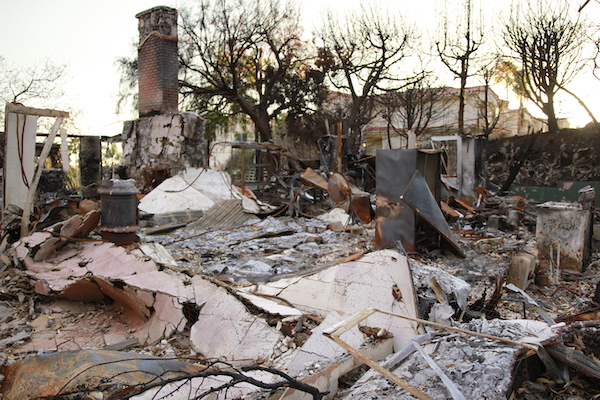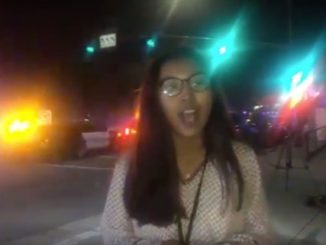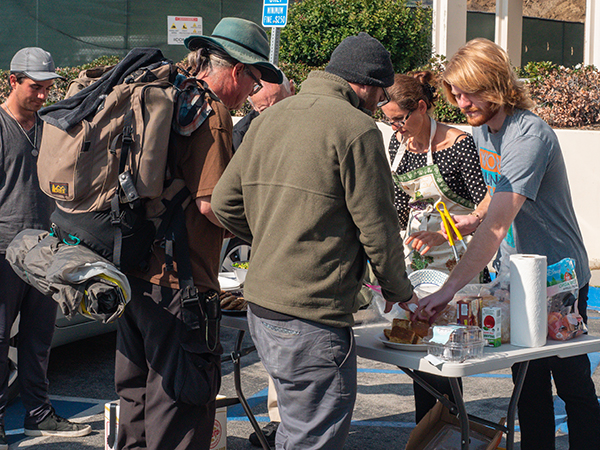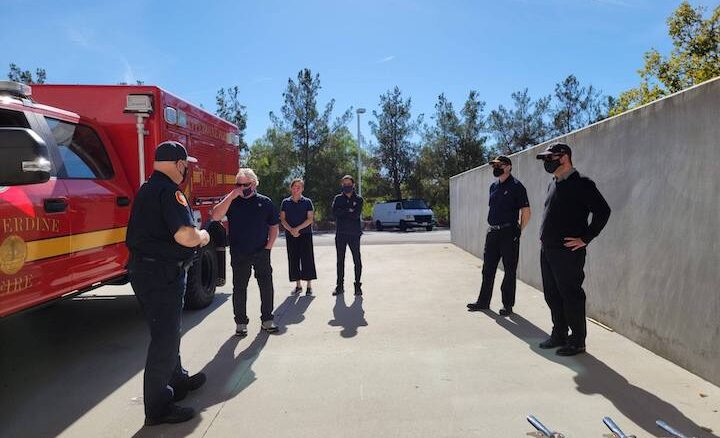
The forecast for Southern California is 0% chance of rain and 100% chance of fire.
In Los Angeles County specifically, lack of rain has made the drought more intense, creating a serious wildfire threat. Pepperdine University is nestled in the Santa Monica Mountain region that is more at risk for drought-induced wildfires.
“We have a calling to recognize this, address it and then seek to educate folks about it,” said Ricky Eldridge, Pepperdine University’s director of Governmental and Regulatory Affairs and the Center for Sustainability.
Pepperdine University has dealt with 20 nearby wildfires in the last 21 years, according to the LA Almanac. There’s a chance of more as the drought isn’t getting any better. Pepperdine Fire Safety prepares year-round for the threat.
An unfortunate situation
Since the early 2000s, California has seen a lack of rainfall yet an abundance of heat waves.
“Drought and heat often go together,” William Patzert, retired oceanographer and climatologist, told the Los Angeles Times in July. “And heat waves over the last two decades have become longer, more frequent, more intense. Droughts are not unusual in the West, and certainly not in California. But the intensity of this one is worse than what we saw in the ’50s and ’60s.”
The current drought is a one-two-three punch because there’s no rain in LA, the Colorado River is dried out and the Northern Sierra Nevada and Southern Cascades are also dry, Benjamin Hatchett, an assistant research professor at the Desert Research Institute, told the Los Angeles Times in July.
Pepperdine officials recognize the complexity of the drought and have put into place various methods to save water.
“Pepperdine is a bit unique in that we have a comprehensive reclaimed water system, originally put in during the campus construction in the 1970s,” Eldridge said. “We use that to irrigate 97% of the developed campus.”
Pepperdine is selective in their plant choice, making sure all landscaping is drought tolerant and fire resistant, Eldridge said. The school also implemented dual flush toilets, low-flow shower heads and ways to minimize potable water use.
The drought and wildfire relationship
No rain means no moisture.
Southern California is simply drying out, leaving lots of material ready to ignite. The Los Angeles County Fire Department Forestry Division measures Live Fuel Moisture levels, that is the water content of plants, to determine wildfire conditions, according to a Malibu press release. When heat, wind and low humidity pushes Live Fuel Moisture low that means more flammable plants.
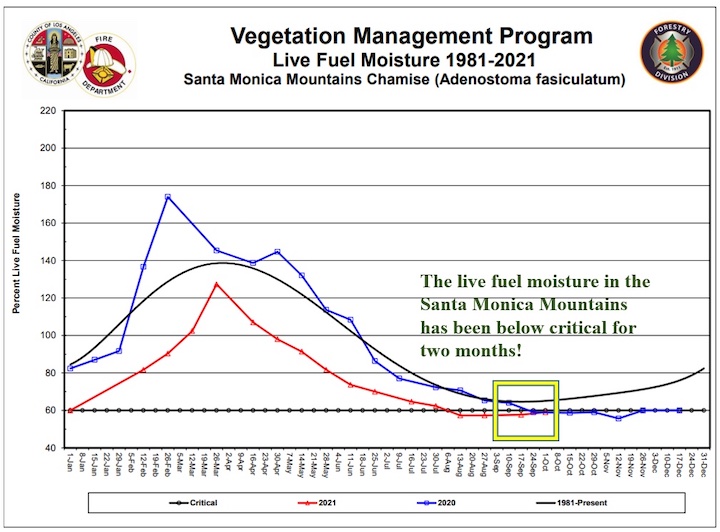
Pepperdine Fire Safety personnel, the university’s own fire fighting unit, actively monitor Low Fuel Moisture to prepare and help prevent wildfires.
“We practice as if we are facing a wildland threat anytime of the year,” said Mark Lauren, lieutenant for Pepperdine’s Fire Safety.
All the firefighters are trained and kept up to date with procedures, Lauren said. The school’s department maintains two Type 6 Wildland Firefighting Engines as well.
“We have our two reclaimed water reservoirs that firefighting helicopters can use,” Eldridge said. “We also have potable water tanks.”
Pepperdine and the wildfire threat
The last major wildfire for Pepperdine was Woolsey in 2018.
The day of the fire was an intense day of events and emotions, according to Pepperdine Graphic reporting. The fire started Thursday night, and by Friday morning, Pepperdine officials enacted shelter-in-place protocols, canceling classes and moving everyone to main campus as Malibu started city-wide evacuations.
Some students left while others sheltered overnight. Pepperdine shelters in place to keep students from danger on overcrowded roads, Lauren said.
“We determined that the safest, best protection we can provide for the entire community here is that we stay on campus,” Lauren said.
Misinformation about Woolsey spread faster than the flames, according to The Pepperdine Graphic. Some people used social media to make false claims about what people at Pepperdine should be doing in response to the fire, like where students should go or do. There were also inaccurate updates on the status of how close the fire was.
Lauren advised people to go straight to centralized information sources.
Sophia Zummo, a senior biology major with a sustainability minor, was on campus during Woolsey and is back now as a senior.
“My freshman year was Woolsey. It was really bad,” Zummo said. “Then sophomore year, before COVID hit there were a lot of small fires through the canyon. I remember waking up and it would be smokey and there were a few rolling blackouts. That made me really scared and anxious because all I knew of fires was Woolsey.”
Pepperdine Fire Safety personnel do annual check-ins with senior administration and LA County Fire Command Staff to constantly reevaluate policies and stay prepared for wildfires, especially after Woolsey.
“We don’t have the same philosophy as the city does,” Lauren said. “We are a shelter-in-place philosophy.”
Campus design
Pepperdine has a particular layout and design in order to keep everyone safe.
“Our campus buildings are appropriately grouped in defensible locations, campus roads are strategically placed to provide natural firebreaks and are intentionally designed so that firefighters can readily reach developed areas and of course we are using fire-resistant building materials,” Eldridge said.
Fire-resistant building materials include poured cement, tile and glass, according to the Architects Training Institute. William Pereira, the campus’ architect, intentionally used those materials.
The campus also has burn space, that is they leave open space from annual brush clearings so potential fires have an area to die out and give firefighters more time to arrive on scene.
“We also have about 550 acres of undeveloped, preserved campus open space, which consists of native vegetation,” Eldridge said.
This is all a part of the burn space. Eldridge said native vegetation responds better to excess carbon dioxide in the atmosphere, decreasing the chance of wildfires.
Students and the wildfire threat
While Pepperdine fire personnel know the latest on wildfires, students have varying levels of knowledge.
“I don’t know anything,” said Alex Ianni , a sophomore liberal arts for education major. “I just know there’s been a lot of fires here. You can feel it when you walk outside since it is pretty dry here.”
The same is true regarding wildfire safety procedures.
“I just know that we have some emergency contact systems,” said Aidan Henegar, a junior religion and economics major. “But other than that I’m not sure and I’m living off campus so I’m not sure what would apply to me anyway.”
Both Hengar and Ianni weren’t on campus when Woolsey happened. Zummo, having lived through that, feels more prepared.
“Malibu’s campus as a whole is very fire-preventative,” Zummo said. “It’s very well thought out.”
Although Pepperdine’s procedures are public information, students indicated they knew little about the policies in place. “They touch a little bit on Pepperdine being a safe place during wildfires at NSO, but there hasn’t been anything to explain what happens specifically in the case of a wildfire,” said Noah Wahamaki, a freshman integrated marketing communication major.
Some students said Pepperdine could do more in the way of preparing students to be more knowledgeable on the drought and wildfires since it is so prevalent.
“I wouldn’t be upset if Pepperdine took the time to educate us on those certain topics,” Wahamaki said. “I think it could be very beneficial to what this drought entails and what the future is going to look like.”
Lauren said he and the rest of Fire Safety coordinate with Housing and Residence Life at Pepperdine. They release fire hazard guidelines, evacuation routes and information on installed fire equipment.
“We constantly train and stay well abreast of what’s going on,” Lauren said. “It won’t be a surprise to us.”
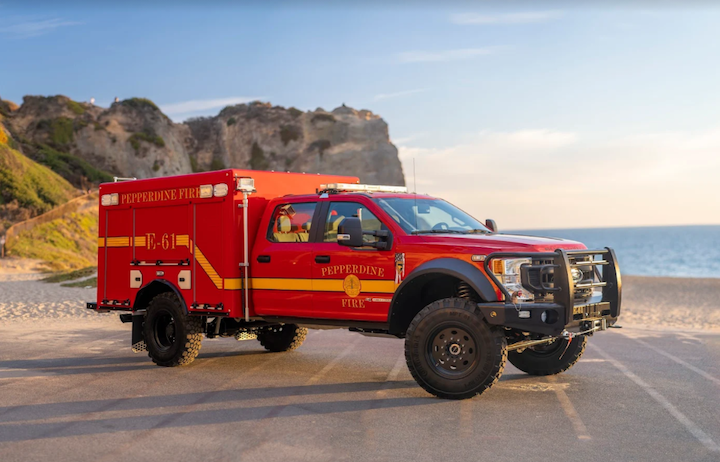
The lingering surprise effect
Students take the risk of having to deal with wildfires in choosing to come to school at Pepperdine.
“There definitely is a lot of anxiety,” Zummo said. “I love Pepperdine. It’s just something I have to deal with living in Malibu.”
Students do their best to not think about the risk. Instead, they focus on hope.
“It’s definitely a little concerning,” Henegar said. “But I think the fact that they had a really big wildfire three years ago now and dealt with that, it gives me more comfort.”
Though students trust Pepperdine is on top of wildfire prevention efforts, there are still a lot of unknowns.
“It’s definitely lingering in the back of my mind that there’s a potential of it happening, but I do know that there are safety procedures put in place,” Wahamaki said. “If anything, it’s driving me to be more conscientious in the way that I am helping or aiding in protecting the wildlife.”
Ianni said she isn’t scared as she believes what’s meant to be will happen.
“If it’s a wildfire, it’s inevitable,” Ianni said “It is what it is.”
Pepperdine is still standing after Woolsey and other fires. Lauren is confident that Fire Safety’s techniques and systems have worked.
“We have successfully had seven major fires in Malibu campus history and have only had minimal loss,” Lauren said. “No loss of life. That’s huge.”
Annie Cook completed the reporting for this story in Jour 241 under the supervision of Dr. Christina Littlefield and Dr. Theresa de los Santos. Dr. Littlefield supervised the web version of the story.

